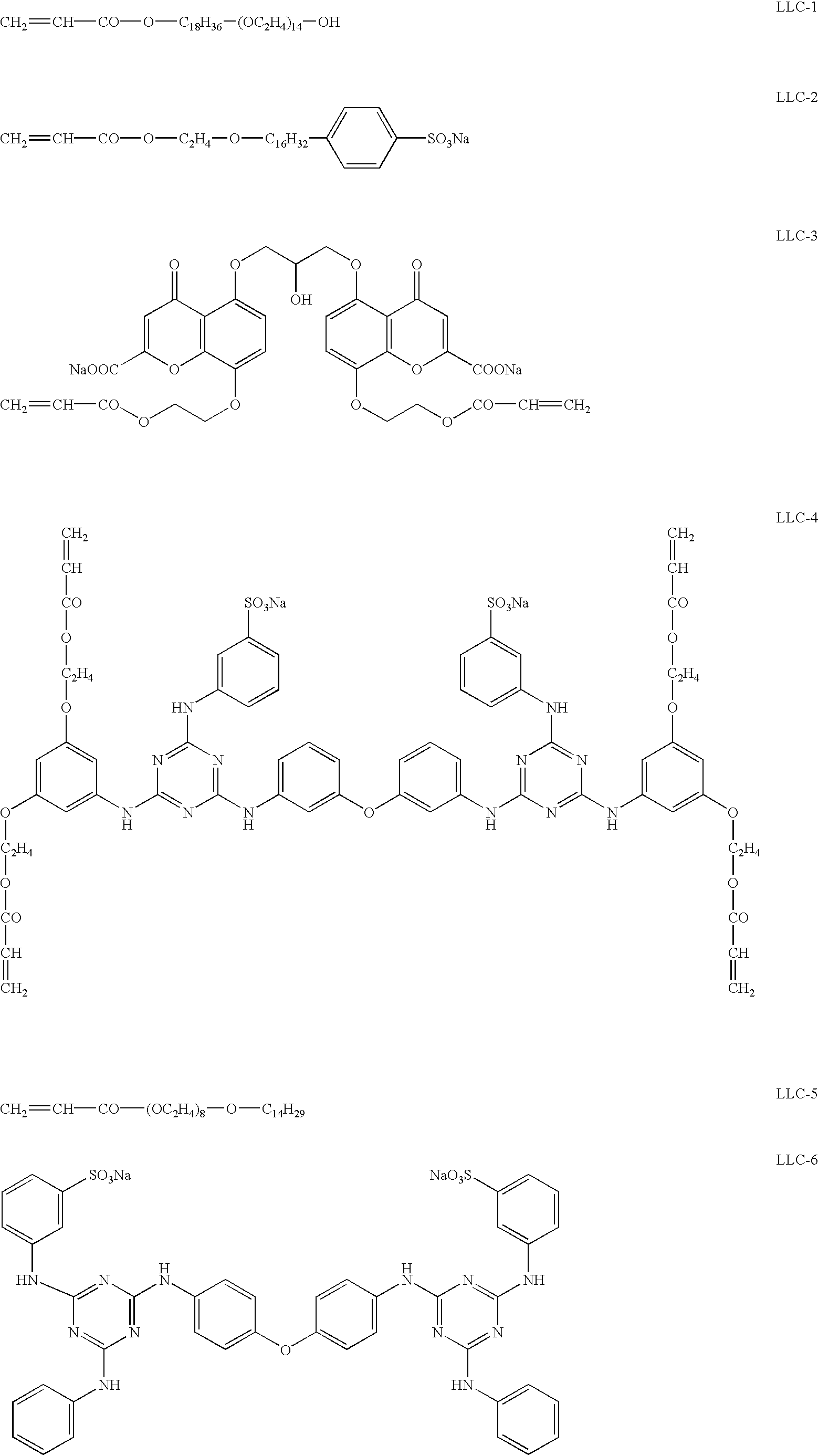Lyotropic liquid crystal composition
a liquid crystal composition and lyotropic technology, applied in the direction of thin material processing, instruments, chemistry apparatus and processes, etc., can solve the problems of difficult to remove opaque silver halide, and difficult to fully reduce silver halide in glass, etc., to achieve easy separation and removal
- Summary
- Abstract
- Description
- Claims
- Application Information
AI Technical Summary
Benefits of technology
Problems solved by technology
Method used
Image
Examples
example 2
Preparation of Lyotropic Liquid Crystal Composition
[0077] In 10 mL of distilled water, 5.0 g of the emulsion (EM-1) prepared in Example 1 and 0.1 g of lyotropic liquid crystal (LLC-1) were added and dissolved by stirring for 30 minutes at room temperature. While the solution was heated and kept at 40.degree. C., 1.3 mg of protease (Actinase E) was added and stirred for 3 hours. The solution was subjected to centrifugation to obtain a concentrated silver halide suspension. The suspension was dispersed in a 40% aqueous solution of lyotropic liquid crystal (LLC-1), and the dispersion was subjected to centrifugation. These dispersing and centrifuging processes were repeated five times to prepare a 40% aqueous solution (Ag-1) of lyotropic liquid crystal (LLC-1) stably dispersing rod-like silver halide grains.
Preparation of Optically Anisotropic Thin Film
[0078] Immediately after a photopolymerization initiator (Irgacure 907) was added to the above-prepared solution (Ag-1) in the amount of...
example 3
Preparation of Gelatin Dispersion Containing Tabular Silver Halide Grains
[0079] The following solutions A to D were prepared.
1 Composition of solution A Ossein gelatin 60.2 g Distilled water 20,000 ml 10 Wt. % ethanol solution 5.6 ml of polyisopropyleneoxy-polyethyleneoxy-sodium salt of disuccinic ester KBr 26.8 g 10 Wt. % H.sub.2SO.sub.4 144 ml
[0080]
2 Composition of solution B AgNO.sub.3 1,487.5 g Distilled water (to make up to) 3,500 ml
[0081]
3 Composition of solution C KBr 1,029 g KI 29.3 g Distilled water (to make up to) 3,500 ml
[0082]
4 Composition of solution D 1.75 N KBr aqueous solution to give the following silver potential
[0083] To the solution A, the solutions B and C in each amount of 64.1 ml were added at 35.degree. C. for 2 minutes according to the simultaneous mixing method by means of a mixer described in Japanese Patent Publication Nos. 58(1983)-58288 and 58(1983)-58289, to form nuclei.
[0084] After the addition of the solutions B and C was completed, the reaction liqu...
example 4
Preparation of Lyotropic Liquid Crystal Composition
[0093] In 10 mL of distilled water, 5.0 g of the emulsion (EM-2) prepared in Example 3 and 0.1 g of lyotropic liquid crystal (LLC-1) were added and dissolved by stirring for 30 minutes at room temperature. While the solution was heated and kept at 40.degree. C., 1.3 mg of protease (Actinase E) was added and stirred for 3 hours. The solution was subjected to centrifugation to obtain a concentrated silver halide suspension. The suspension was dispersed in a 40% aqueous solution of lyotropic liquid crystal (LLC-1), and the dispersion was subjected to centrifugation. These dispersing and centrifuging processes were repeated five times to prepare a 40% aqueous solution (Ag-2) of lyotropic liquid crystal (LLC-1) stably dispersing tabular silver halide grains in the amount of 10 wt. %.
Preparation of Optically Anisotropic Thin Film
[0094] Immediately after a photopolymerization initiator (Irgacure 907) was added to the above-prepared solutio...
PUM
 Login to View More
Login to View More Abstract
Description
Claims
Application Information
 Login to View More
Login to View More - R&D
- Intellectual Property
- Life Sciences
- Materials
- Tech Scout
- Unparalleled Data Quality
- Higher Quality Content
- 60% Fewer Hallucinations
Browse by: Latest US Patents, China's latest patents, Technical Efficacy Thesaurus, Application Domain, Technology Topic, Popular Technical Reports.
© 2025 PatSnap. All rights reserved.Legal|Privacy policy|Modern Slavery Act Transparency Statement|Sitemap|About US| Contact US: help@patsnap.com

